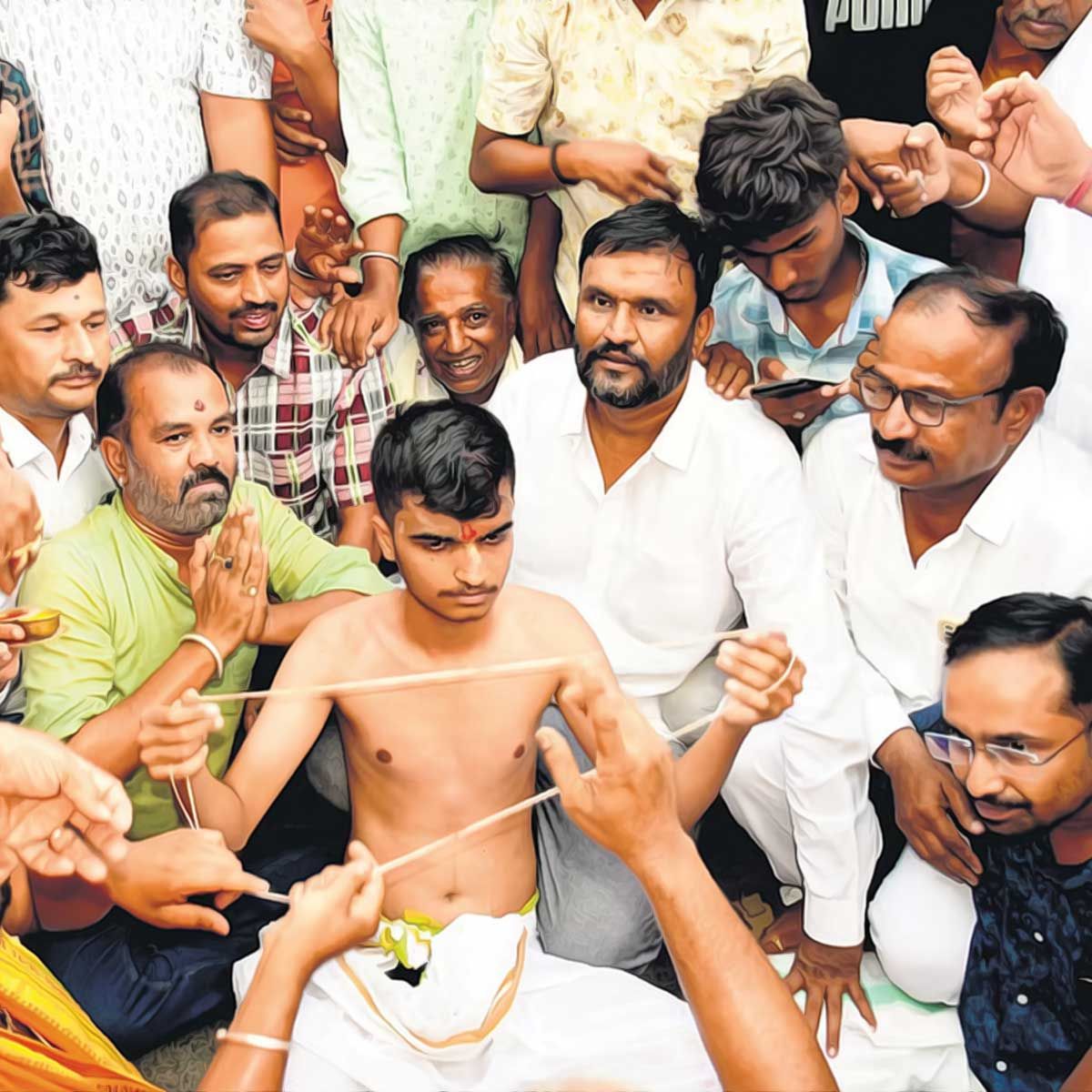More Coverage
Twitter Coverage
Satyaagrah
Written on
Satyaagrah
Written on
Satyaagrah
Written on
Satyaagrah
Written on
Satyaagrah
Written on
JOIN SATYAAGRAH SOCIAL MEDIA
"Blackout": India launches its first nationwide civil defense drill since 1971 after 26 Hindu tourists killed in the Pahalgam terror attack, suspends the Indus Waters Treaty, seals borders, cancels Pakistani visas & cracks down on cross-border terrorism

On May 7, the Government of India will carry out a nationwide civil defense mock drill that is likely to remain etched in public memory, especially after the Pakistan-backed Pahalgam terror attack. That horrifying incident in the scenic Baisaran Valley left 26 Hindu tourists dead and many others severely injured. In response to this rising cross-border threat, the Ministry of Home Affairs (MHA) has issued specific instructions to 244 districts across the country to participate in this critical mock exercise.
This isn't just another routine drill. It’s a simulation of real wartime conditions, involving procedures like evacuation protocols, air raid sirens, and power blackouts—activities that most Indians today have never experienced in real life. The goal is to assess how prepared civilians and emergency services are, should a war-like situation arise. The intensity and scale of this drill mark a significant moment in India’s civil defense history. It is the first such nationwide effort since 1971, when India had played a decisive role in freeing Bangladesh from Pakistan's oppressive regime. This time, however, the threat looms once again from the same hostile neighbor, pushing the Indian government to take precautionary steps.
Citizens in various parts of the country will hear air raid sirens blaring as they engage in simulated sheltering exercises. These drills will be held at more than 250 locations, cutting across 33 states and union territories—including Delhi, Andhra Pradesh, Assam, Chhattisgarh, Chandigarh, Uttarakhand, West Bengal, Goa, and many others.
The practice will also include abrupt blackouts, concealment of critical infrastructure like power plants and refineries, and updated evacuation strategies. It is designed to test how quickly and effectively the administration, armed forces, and public can respond to war-like emergencies.
The core objective is clear: to evaluate readiness during possible missile strikes, aerial bombardments, or full-scale attacks. Authorities want to ensure swift, coordinated, and calm responses under stress. During the drills, emergency teams will operate in real-time conditions. Civilians will rehearse how to seek cover, city lights will be turned off, and air sirens will create a realistic atmosphere of crisis. The exercises are also expected to lessen panic, improve public awareness, and ultimately save lives in the event of a real conflict.
There may be traffic disruptions, temporary mobile signal blackouts, or even emergency announcements during this time. Some regions might see police and paramilitary forces simulate a warzone, creating scenes that feel like active warfare, though only for training purposes.
Officials have made it clear, however, that this drill does not indicate an upcoming war. Instead, it’s part of a long-standing framework under the Civil Defence Rules of 1968, which date back to the Cold War era. These regulations are now being updated to suit modern threats, and the May 7 drill is a way to ensure India’s capability to respond quickly, cohesively, and confidently if the situation ever demands it.
|
What are Civil Defense Areas?
At the heart of this large-scale national effort lie civil defense districts, which are pre-identified zones tasked with implementing emergency preparedness plans. These areas play a crucial role in both planning and executing local responses to potential national crises. They are responsible not only for training volunteers but also for ensuring smooth coordination between the police, administration, and civilians.
The Government of India actively runs various civil defense operations in these districts. Their key responsibilities include executing evacuation plans, conducting air raid and blackout drills, organizing public awareness drives, and maintaining shelter facilities. They also ensure effective collaboration with other response teams like the Home Guards, NCC (National Cadet Corps), NSS (National Service Scheme), Nehru Yuva Kendra Sangathan (NYKS), and the local police and authorities.
Several factors determine whether a district is classified as a civil defense area:
Proximity to international borders: Districts in Jammu & Kashmir, Punjab, Rajasthan, and Gujarat are prioritized since they lie closest to Pakistan and are likely first points of confrontation.
Presence of key infrastructure: Areas with communication hubs, power grids, ports, refineries, and defense establishments are included because of their strategic importance.
Population and urban density: Metropolitan regions with high populations face greater risk and thus require more robust preparedness.
Coastal sensitivity: Coastal districts vulnerable to maritime threats are also classified for their crucial role in India’s defense matrix.
This classification system ensures that India’s most sensitive and vulnerable zones are equipped to manage emergencies efficiently and minimize chaos.
As per Directorate General (DG) Vivek Srivastava, “We have been doing these civil defence drills in districts on a regular basis but this time it will be pan-India. The exercise could spread out over a couple of days,” he told CNN-News18.
Authorities further clarified that “the purpose of the mock drills was to assist India in reviewing the civil defense SOP (Standard Operating Procedure) in case of an emergency rather than to incite fear.” These drills are more about strategic foresight than panic, aiming to empower communities and strengthen national defense preparedness.
|
Main objective of mock drills
India’s upcoming nationwide civil defense mock drill on May 7 is not just a symbolic move. It is a detailed, structured exercise aimed at thoroughly evaluating the country’s preparedness in case of a war-like emergency. The scale of coordination involved is massive, covering every layer of society and administration.
From the district administrations managing local response coordination to home guards and civil defense wardens taking charge of on-ground implementation, the network is vast and complex. Students, members of the National Cadet Corps (NCC), National Service Scheme (NSS), and Nehru Yuva Kendra Sangathan (NYKS) will provide community support and awareness. Meanwhile, police and paramilitary forces will simulate actual emergency situations, making the drills as realistic as possible. After the completion of the drills, States and Union Territories will be required to submit “Action Taken Reports”, documenting observations, reviewing performances, and suggesting necessary improvements.
The main objectives of this drill are wide-ranging:
To evaluate the efficiency of air raid warning systems.
Hotline and radio communication links with the Indian Air Force are operationalized.
To evaluate how well control rooms and shadow control rooms function.
Instruction on civil defense topics for students, citizens, and others to ensure they can defend themselves in the case of an enemy assault.
The availability of crash blackout measures.
Early camouflage of essential plants and installations.
To confirm that civil defense services, such as depot management, firefighting, rescue operations, and warden services, have been activated and are responding.
To assess the application of crash blackout procedures.
To determine how well evacuation preparations are created and carried out.
Though civil defense strategies originated during the Cold War, when the threat of nuclear and aerial attacks was looming, the relevance of these techniques continues today. Missile attacks, drone warfare, and coordinated terror operations remain active threats, making evacuations, blackout strategies, and communication readiness more essential than ever.
The Indian government has adapted these historical methods with modern technology—for example, using real-time surveillance, media partnerships, and smartphone alert systems. These upgrades ensure not just speed but also clarity and wide reach during emergencies.
There’s also a deep historical importance to this drill. The last nationwide civil defense exercise took place before the 1971 Bangladesh Liberation War, when citizens were taught how to cover windows, take shelter, and defend themselves during air raids. These methods were instrumental in maintaining civilian safety, and the present generation—largely unfamiliar with such experiences—will now gain that essential training.
|
What will happen during mock drills
As per the Civil Defense Act, every district has a designated authority to manage civil defense. This role is typically held by the District Collector or the District Magistrate (DM). Starting on 7th May, these officials will review and update the list of registered civil defense volunteers, including contact numbers, to ensure immediate access in an emergency.
A senior official informed that “this will be to test the operational efficacy in vulnerable districts and train civilians. It is a multi-stakeholder exercise that will be undertaken.” Another officer added, “The list should be at the ready disposal of the DM to deploy the volunteers in times of emergency. It is a requirement under the Geneva convention to protect civilians in times of war.”
The official further emphasized, “So we must empower them, train them to protect themselves. The last such training was in 1999 and before that in 1971. Most young people of this generation are unaware of such a situation. Hence the necessity of the drill.”
The drill will include several vital activities, designed to strengthen emergency response mechanisms in both cities and rural regions:
Activation of air raid sirens: These sirens will be tested in every participating district. The purpose is to verify how well the public alert system performs. A civil defense officer noted, “It is the first step which warns civilians in an emergency situation. The Air Force sounds the alert and each district must ensure that its air raid warning sirens are functioning properly.”
Bunkers: People in forward areas, such as Uri in Kashmir, are being asked to locate and rehearse using community bunkers. These shelters are now being cleaned and inspected. In border villages like Arnia, schoolchildren have already practiced emergency evacuations to ensure their safety during airstrikes or conflicts.
Crash blackouts: This drill includes turning off all visible lights to avoid detection from enemy aircraft during nighttime attacks. As one official explained, “If a blackout siren is sounded, the standard operating procedure must be followed. The drill will assess whether the sirens are working and how effectively people respond. All stakeholders should be well-versed with the SOP.”
Camouflage exercises: Key infrastructure like communication centers, military bases, and power plants will undergo camouflage testing. This is to simulate hiding critical sites from aerial or satellite surveillance during potential wartime scenarios.
Evacuation drills: These will involve moving civilians from high-risk zones to safer locations, testing not only transportation logistics but also the ability of rescue teams to act quickly and calmly under pressure.
Safety of vital installations: A clearly codified list includes locations such as hospitals, paramilitary units, and defense facilities. Civil defense personnel highlighted, “There is no scope for interpretation here. The list will be available to all concerned and as soon as the order comes everyone will have to work together to ensure that the vital installations as mentioned in the list are protected.”
Civil Defence training: Sessions will be held at schools, colleges, offices, and community centers, teaching citizens how to find shelter, perform basic first aid, and remain calm during emergencies. The training also connects the public with civil defense volunteers, so they know who to turn to in a real crisis. During the drill, officials will publicly review evacuation procedures and help institutions finalize their safety plans.
This drill is not just a test of logistics but a nationwide awakening to the importance of community-level readiness. Through this exercise, India is reviving its long-dormant civil defense infrastructure, equipping its people with the tools, training, and awareness they need to withstand modern threats with courage and coordination.
India punishes Pakistan after Pahalgam attack
The timing of India’s nationwide civil defense drill on May 7 is not coincidental—it comes as a direct and calculated response to rising hostility from Pakistan, particularly after the Pahalgam terror attack. The tragic assault, which claimed the lives of 26 Hindu pilgrims, has reignited India’s focus on national security, and the drill is one of several measures being implemented to tackle increasing ceasefire violations along the Line of Control (LoC) in Jammu and Kashmir.
This exercise signals more than just preparation—it reflects India's serious reaction to cross-border threats. The Indian leadership, under Prime Minister Narendra Modi, issued a firm warning to those behind the Pahalgam attack, vowing to punish the perpetrators “beyond their imagination” and pursue them to the “ends of the earth.”
While India prepared itself, a visibly shaken Pakistan responded with its usual narrative—a mix of victimhood, racial undertones, blame-shifting, and threats of nuclear escalation. They went as far as accusing India of staging a false flag operation, even requesting a private session at the United Nations Security Council (UNSC). However, their attempts were dismissed, with no significant global support for their claims.
Meanwhile, the Indian government began serious internal consultations. Prime Minister Modi held multiple high-level meetings, bringing together the Cabinet Committee on Security (CCS) and senior defense and intelligence officials to evaluate India’s counter-strategy. These gatherings weren’t just formalities—they were part of a comprehensive plan to hold Islamabad accountable for sponsoring terrorism and inciting proxy war in Jammu and Kashmir.
The long-standing strategy employed by Pakistan—to “bleed India by a thousand cuts”—now appears to have faced a decisive pushback. In the hours following the Pahalgam massacre, Prime Minister Modi abruptly cut short his official trip to Saudi Arabia and returned to New Delhi. There, he met with National Security Advisor Ajit Doval, Union Home Minister Amit Shah, Defence Minister Rajnath Singh, and External Affairs Minister S. Jaishankar to chalk out urgent measures.
Amit Shah, in particular, rushed to Jammu and Kashmir, where he engaged in on-ground assessments and held meetings with Chief Minister Omar Abdullah and Lieutenant Governor Manoj Sinha. The government signaled that India was no longer just reacting but was actively taking steps to isolate Pakistan diplomatically, economically, and militarily.
|
India’s Multi-Layered Response to Pakistan
India’s retaliation extended beyond statements. It was concrete, layered, and broad-spectrum:
🔺 Indus Waters Treaty suspended
India suspended the 1960 Indus Waters Treaty, a pivotal water-sharing agreement brokered by the World Bank, which governs the distribution of the Indus River system. This move halted all cooperation on river water management and signaled a shift in India’s stance on long-standing bilateral treaties. In retaliation, Pakistan suspended the 1972 Simla Agreement.
🚫 Closure of the Wagah-Attari Border
India shut down the Wagah-Attari border indefinitely, a critical point for both trade and civilian movement. The traditional Beating Retreat ceremony held at this border was also discontinued. This was aimed at cutting off routine diplomatic gestures and increasing Pakistan’s regional isolation.
🔻 Scaling back diplomatic relations
India took a hardline diplomatic stand by downgrading official engagement, recalling its diplomats, and expelling several senior Pakistani officials from Indian soil.
⚠️ Pakistani military diplomats declared persona non grata
Several Pakistani military and intelligence officials were officially declared persona non grata. India alleged that they had been involved in espionage and activities that violated the ethics of diplomatic conduct.
❌ Revoking SAARC and other Pakistani visas
Citing growing security concerns, India cancelled all active visas granted to Pakistani nationals—including those issued under the SAARC (South Asian Association for Regional Cooperation) framework. This decision significantly affected academic exchanges, business travel, and cultural events.
Foreign Secretary Vikram Misri confirmed, “Any SVES (Saarc Visa Exemption Scheme) visas issued in the past to Pakistani nationals are deemed cancelled. Any Pakistani national currently in India under SVES visa has 48 hours to leave India.”
🛫 Pakistani airlines banned from Indian airspace
India also prohibited Pakistani commercial flights from using Indian airspace, compelling them to take longer and more expensive routes, thereby increasing fuel consumption and operational costs. This had both financial and symbolic consequences.
📦 Commercial ties cut
India suspended all imports and exports with Pakistan, including third-country trade routed via the UAE or Singapore. The government also blocked informal trade through Jammu and Kashmir, applying economic pressure on Pakistani industries.
🚢 Shipping and maritime services halted
All forms of logistical and shipping cooperation with Pakistan were stopped, including joint cargo agreements and port coordination. Ports in Gujarat and Maharashtra that occasionally handled Pakistani shipments were officially notified.
📮 Postal communication discontinued
India stopped all postal services, including letters, diplomatic parcels, and civilian packages. This further severed everyday and diplomatic communication, underlining a complete breakdown in mutual trust.
📵 Pakistani media and social media content restricted
The government began cracking down on Pakistani content across digital platforms. This included:
Suspending propaganda-linked social media pages
Taking down provocative YouTube content
Blocking Pakistani media sites
Warning streaming platforms against airing Pakistan-based shows
This was done to safeguard internal peace and block narratives that glorify terrorism or provoke unrest.
🕊️ Briefing the UNSC
India confidentially **briefed UNSC members—excluding China and Pakistan—**about Islamabad’s ties to terror groups. Backed by site intelligence from the Pahalgam attack, India aimed to build global consensus against Pakistan’s role in cross-border terrorism.
⚡ Boosting hydroelectric storage in Kashmir
According to Reuters, India has begun expanding storage capacity at two hydroelectric projects in Kashmir. This marks India’s first significant departure from the Indus Waters Treaty, a pact that had remained intact despite three wars and repeated tension between the nuclear neighbors.
💸 Demanding reduced aid to Pakistan
During the 58th Annual Meeting of the Asian Development Bank (ADB) in Milan, Finance Minister Nirmala Sitharaman urged ADB President Masato Kanda to reduce grants to Pakistan, signaling India’s commitment to choking terror financing globally.
🏚️ Demolition of terrorist properties
Indian security forces demolished at least nine homes belonging to terror suspects or their families in Kupwara, Bandipora, Pulwama, and other districts. The first to be razed was the residence of Adil Ahmad Thoker, a Lashkar-e-Taiba terrorist believed to be involved in the Pahalgam attack. Authorities also arrested those who expressed sympathy with militants, taking a zero-tolerance approach.
These measures represent a comprehensive and unprecedented crackdown by India in response to Pakistan’s continued support for terrorism. From diplomatic isolation to economic penalties, from national drills to global advocacy, India is ensuring that the Pahalgam attack does not go unanswered—not just militarily but on every possible front.
Regular ceasefire violations, BSF soldier kidnapped
While Pakistan continues to portray itself as a victim on international platforms, the ground reality along the Line of Control (LoC) paints a very different picture. The Pakistani army has repeatedly violated the ceasefire agreement by firing small arms without provocation at Indian posts, intensifying tensions along the border. Over the past twelve consecutive nights, Indian territories have witnessed these unprovoked assaults, prompting swift and proportional retaliation by the Indian Army.
A defence spokesperson from Jammu confirmed the situation, stating, “During the night of May 5-6, Pakistan Army initiated unprovoked small-arms fire across the LoC in areas opposite Kupwara, Baramulla, Poonch, Rajouri, Mendhar, Naushera, Sunderbani, and Akhnoor. The Indian Army responded promptly and proportionately.”
According to the report, five out of the seven border districts in Jammu and Kashmir—namely Kupwara, Baramulla, Poonch, Rajouri, and Jammu—were impacted by these hostile actions. Thankfully, Samba and Kathua districts, which lie closer to the International Border, reported no such incidents during this wave of escalation.
The repeated breaches have rendered the February 2021 ceasefire agreement increasingly ineffective. The pact, originally seen as a stabilizing mechanism between the two nuclear-armed nations, now appears hollow in light of Pakistan’s consistent violations across the 740-kilometre-long LoC. The latest series of attacks originated in Kupwara and Baramulla—the northern districts of Kashmir—and gradually extended southwards to Rajouri, Poonch, Akhnoor, and even the Pargwal subdivision of Jammu.
This aggressive pattern began on April 24, the same evening India suspended the Indus Waters Treaty in response to the Pahalgam massacre. The sequence of events is not coincidental—it demonstrates how quickly Pakistan’s hostile posture escalated after India began exerting diplomatic and economic pressure.
Adding to the tension, a disturbing incident unfolded in Punjab, where a Border Security Force (BSF) soldier was detained by Pakistan Rangers after unintentionally crossing the border. Constable Purnam Kumar Shaw from the 182nd BSF battalion had been posted near farmland close to the Indo-Pak border in Ferozepur, Punjab. While accompanying local farmers, he reportedly stepped beyond the boundary fence and inadvertently entered Pakistani territory.
At the time of the incident, he was fully dressed in uniform and carried his service rifle. After lying down to rest in the shade, he was captured by Pakistani troops, who later delayed his return. Indian and Pakistani representatives held a flag meeting to resolve the matter, yet Shaw has not been released. The only response from the Pakistani side has been: “We are waiting for directions from the higher-ups.”
In an unexpected turn of events, days later, Indian forces from the Rajasthan frontier of the BSF apprehended a Pakistani Ranger near the border. This development came almost a fortnight after Shaw’s arrest, indicating rising border tensions and highlighting the unpredictable nature of Indo-Pak border dynamics.
Pahalgam terror attack
The horrific events that unfolded in Pahalgam on 22nd April shocked the nation. Terrorists supported by Pakistan murdered 26 Hindu tourists, specifically targeting them after confirming their religious identity. This was not a random attack—it was a premeditated act of religious hate. According to reports, the assailants asked for names, identity cards, and even forced victims to remove their pants to check for religious markers. They then demanded the recitation of Islamic verses, and upon refusal, executed the non-Muslim individuals without mercy.
Family members and multiple eyewitnesses confirmed this disturbing sequence of events, adding to the growing evidence of Pakistan’s direct involvement.
In the aftermath, Jammu and Kashmir Police released sketches of three suspected terrorists and announced a reward of ₹20 lakh for any information leading to their capture. The Resistance Front (TRF), a well-known proxy of Lashkar-e-Taiba (LeT) operating from Pakistan, initially claimed responsibility for the attack. However, in a contradictory statement later, they blamed a “coordinated cyber intrusion” for the message, attempting to retract the claim.
What’s even more concerning is that the attackers were believed to be highly trained, having received elite military training in Pakistan. This includes training by the Special Service Group (SSG)—Pakistan’s elite commando force. Among the three assailants was Hashim Musa, a former para-commando of the SSG, who later joined Lashkar-e-Taiba and has since participated in several terror attacks across Jammu and Kashmir.
Hashim Musa entered India in 2023, and intelligence reports link him to at least six major terror incidents, including the October 2024 Ganderbal attack that killed seven civilians, and another strike in Baramulla, where four security personnel lost their lives. Authorities believe Musa is hiding in the dense forests of South Kashmir, and a full-scale manhunt is underway to locate him.
Given Pakistan’s overt involvement in nurturing, training, and deploying terrorists, India is preparing for a firm and fitting response. The unprecedented measures taken in recent weeks—spanning diplomatic isolation, economic disengagement, and military readiness—are part of a broader national policy to punish Pakistan for endangering innocent Indian lives.
India is now more determined than ever to confront state-sponsored terrorism at its roots, especially when it takes the form of religiously motivated massacres like the one at Pahalgam. This is not just about retaliation—it is about sending a message that such barbarism will not be tolerated, and those responsible will face consequences beyond their imagination.
 |
 Support Us
Support Us
Satyagraha was born from the heart of our land, with an undying aim to unveil the true essence of Bharat. It seeks to illuminate the hidden tales of our valiant freedom fighters and the rich chronicles that haven't yet sung their complete melody in the mainstream.
While platforms like NDTV and 'The Wire' effortlessly garner funds under the banner of safeguarding democracy, we at Satyagraha walk a different path. Our strength and resonance come from you. In this journey to weave a stronger Bharat, every little contribution amplifies our voice. Let's come together, contribute as you can, and champion the true spirit of our nation.
 |  |  |
| ICICI Bank of Satyaagrah | Razorpay Bank of Satyaagrah | PayPal Bank of Satyaagrah - For International Payments |
If all above doesn't work, then try the LINK below:
Please share the article on other platforms
DISCLAIMER: The author is solely responsible for the views expressed in this article. The author carries the responsibility for citing and/or licensing of images utilized within the text. The website also frequently uses non-commercial images for representational purposes only in line with the article. We are not responsible for the authenticity of such images. If some images have a copyright issue, we request the person/entity to contact us at This email address is being protected from spambots. You need JavaScript enabled to view it. and we will take the necessary actions to resolve the issue.
Related Articles
- Operation Trident,1971: How Indian Navy Pulled Off One Of Its Greatest Victories over Pakistan, Karachi burned for seven days
- Past unfolding: Hindu holy city of Dwarka was targeted by Pakistan in 1965 with an aim to destroy it
- India successfully carried out the test firing of a new missile of the Agni series known as Agni-Prime
- Rare footage of Pakistan Army surrendering to Indian Armed Forces after the humiliating defeat in 1971 war: Vijay Diwas
- Prophecies of Jogendra Nath Mandal getting real after seventy years of his return from Pakistan
- Kashmir humiliates Pakistan and gives cold shoulder to Pakistan sponsored ‘Kashmir Solidarity Day’ as no public speeches, rallies on the eve from the public or separatist movements or any special prayers in mosques
- Manmohan Singh govt was ready to demilitarise the Siachen glacier and cede the control to Pakistan under the pressure of Americans, wanted to call it ‘Mountain of Peace’: Former Chief of Army Staff General JJ Singh
- Direct Action Day triggers The Great Calcutta Killings: Kolkata Paid Its Lives To Create Pakistan
- UP mass conversion: How Darsh Saxena, Rajeshwari and Priyanka became Mohd Rehaan Ansari, Razia and Fatima, more details emerge
- Supreme Court dismisses plea seeking protection of Hindus from the Muslim community in Mewat
- Haunting history- 50 years of Operation Searchlight in Dhaka
- Indian Army pacing towards self-reliance under 'Atmanirbhar Bharat Abhiyaan’ campaign: Indigenisation of defence manufacturing is helping to build a new and strong India to keep neighbour aggression in check
- On 16th Aug 1946, during Ramzan's 18th day, Direct Action Day aimed to provoke Muslims by mirroring Prophet Muhammad's victory at Badr, Gopal 'Patha', the Lion of Bengal, heroically saved Bengali Hindus & Calcutta from a planned genocide, altering history
- Twitter rewards an Islamist org, set to be banned by India, with a verified blue tick: Here is what PFI has done in the past
- Kashmir students to be barred from Govt jobs and booked under UAPA for Anti-India Sloganeering During Pak Match




























